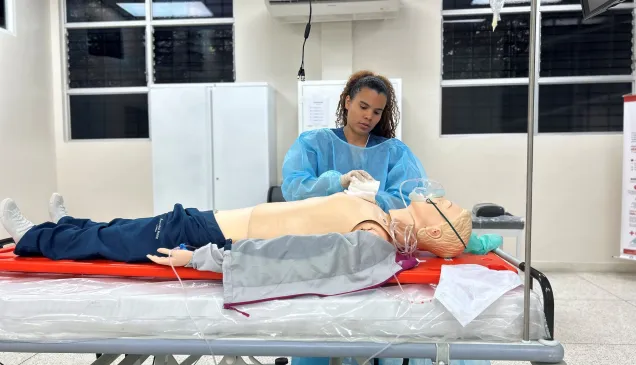General debate on all disarmament and international security agenda items. United Nations, General Assembly, 69th session, First Committee, statement by the ICRC, New York, 14 October 2014.
In the course of its humanitarian work in countless armed conflicts and other situations of violence around the world, the International Committee of the Red Cross (ICRC) has witnessed first-hand the high cost to civilians of insufficient controls on the availability of conventional weapons. In addition to prolonging armed conflicts, weak controls on arms availability have facilitated violations of international humanitarian law, endangered humanitarian assistance and caused the displacement of millions of civilians. Even after wars have ended, high levels of armed violence and insecurity have continued because weapons have remained too easily available.
The ICRC is therefore very pleased that the Arms Trade Treaty (ATT), which the General Assembly adopted only 18 months ago, will enter into force at the end of this year. Today more than 120 States – well over half the world's countries – have ratified or signed the Treaty, thereby committing to its humanitarian goal of reducing human suffering through strict controls on the international trade in conventional arms. We encourage all States to adhere to the ATT at the earliest opportunity.
At the heart of the Treaty is the recognition of each State's duty to respect and ensure respect for international humanitarian law. Faithfully and consistently applied, the Treaty will ensure that weapons do not end up in the hands of those who would use them to commit war crimes or serious violations of human rights law.
While congratulating States for the imminent entry into force of the ATT, the ICRC is aware that the flow of weapons continues to feed some of the most brutal armed conflicts. We remind all arms-exporting States – even those not bound by existing instruments regulating arms transfers – that they must refrain from transferring weapons to warring parties that are manifestly perpetrating war crimes, or where there is a substantial risk that they would do so.
It is not just the availability of conventional arms that engenders civilian suffering. The types of conventional weapons chosen by belligerents when fighting in populated areas are also of concern. This year alone, a number of armed conflicts have seen the use in populated areas of explosive weapons with a wide impact area, such as large bombs or missiles, unguided indirect-fire weapons including artillery and mortars, and weapons systems designed to deliver multiple munitions over a wide area. The ICRC considers that explosive weapons with a wide impact area should be avoided in densely populated areas due to the significant likelihood of indiscriminate effects and despite the absence of an express legal prohibition against specific types of weapons.
Recent conflicts show that there is a need for States to pay greater attention to this important humanitarian issue. In its day-to-day work to protect and assist civilians affected by armed conflict, the ICRC continues to witness the devastating human cost of such weapons, in terms of incidental or indiscriminate death and injury and severe damage to critical civilian infrastructure. Damaged or destroyed buildings are the most visible effects of the use of explosive weapons in populated areas. Less visible is the damage caused to vital water and electrical supply systems, which has severe adverse consequences on the functioning of hospitals and more generally on the survival of the civilian population. Moreover, the loss of homes and livelihoods caused by explosive weapons in populated areas leads to the long-lasting displacement of civilians. These effects raise questions about the choice of means and methods of warfare, including whether it is appropriate, in populated areas, to employ weapons that have been designed for combat in an open battlefield, or otherwise to employ large amounts of explosive force.
In his November 2013 Report on the Protection of Civilians in Armed Conflict, the Secretary-General encouraged States to share information on their respective policies, operational practices and lessons learned on the use of explosive weapons in populated areas, which would contribute to informing discussions and to eventually developing policy guidance. The ICRC joins the Secretary-General in this call.
Though every day the ICRC observes and responds to the effects on civilians of conventional weapons, the threat of nuclear weapons remains a serious concern in humanitarian terms. In this regard, in 2011 the International Red Cross and Red Crescent Movement appealed to States to ensure that nuclear weapons were never used again and to urgently pursue negotiations to prohibit and completely eliminate nuclear weapons on the basis of existing commitments and international obligations. At the same time, we expressed the difficulty of envisaging how any use of nuclear weapons could be compatible with international humanitarian law. The ICRC welcomes the increased attention that States are paying to the humanitarian impact of these weapons, including through the Oslo and Nayarit conferences and the forthcoming Vienna conference. Evidence of the immediate and long-term effects of the use of any nuclear weapon, including as a result of an accidental detonation, confirms that nuclear disarmament remains a humanitarian imperative. It is our hope that the 2015 Non-Proliferation Treaty Review Conference will recognize the urgent need for robust action to advance nuclear disarmament.
Finally, the ICRC wishes to address two new technologies of warfare about which there continues to be much debate internationally: autonomous weapons and cyber warfare. It should first be recalled that their development is not occurring in a legal vacuum. As with any new weapon, means or method of warfare, they must be capable of being used in accordance with international humanitarian law, in particular the principles of distinction, proportionality and precautions in attack. However, the unique characteristics and foreseeable impact of these new technologies of warfare raise questions about whether existing legal rules are sufficiently clear.
The ICRC welcomes the increased attention the international community is paying to autonomous weapon systems, including in the framework of the Convention on Certain Conventional Weapons (CCW). In the last year, discussions about these weapons in the CCW and other forums have led to a better understanding of the technological capabilities, military intent and legal and ethical issues raised by this new technology of warfare.
Although there is no universally accepted definition of an 'autonomous weapon system,' common to all proposed definitions is the capability of independently attacking targets without human intervention. As such, in the ICRC's view, the defining feature of autonomous weapons is autonomy in the 'critical functions' of searching for, identifying, selecting and attacking targets. There is often a sense that these are weapons of the far future, but increasing autonomy already exists in the 'critical functions' of some weapon systems in use today.
There is a danger that increasing autonomy in the critical functions of weapon systems will substitute human decision-making with that of machines, thereby posing significant legal and ethical concerns. Current technological capabilities and foreseeable developments raise serious doubts about the ability to use autonomous weapon systems in compliance with international humanitarian law in all but the narrowest of scenarios and the simplest of environments. And beyond doubts about legal compliance are fundamental concerns about the ethical and moral acceptability of allowing machines to independently take life-and-death decisions. There is a need to ensure appropriate or meaningful human control or judgement over the use of force, including the use of lethal force against human targets.
Autonomous weapons raise profound legal, ethical and societal questions for the future of warfare and of humanity and thus warrant the continued attention of States. The ICRC urges the States party to the CCW, at their annual conference in November, to extend the mandate for the discussion of autonomous weapon systems into 2015.
The potential human cost of cyber warfare is also a matter of concern. Cyber warfare refers to operations against a computer or a computer system through a data stream, when employed as means and methods of warfare. Cyber attacks against transportation systems, electricity networks, dams and chemical or nuclear plants could have devastating consequences. The ICRC welcomes the fact that the 2013 Report of the United Nations Group of Governmental Experts on Developments in the Field of Information and Telecommunications in the Context of International Security confirmed the applicability of international law in this regard. Indeed, cyber warfare is subject to the limits imposed by international humanitarian law on all new weapons, means and methods of warfare, in particular the prohibition on directing attacks against civilian objects and the prohibition on indiscriminate and disproportionate attacks.
Even though existing rules apply to cyber warfare, the interconnectedness of military and civilian networks poses a significant practical challenge in terms of protecting civilians from the dangers of cyber warfare. This challenge underscores the importance for States that develop or acquire cyber-warfare capabilities – whether for offensive or defensive purposes – to assess their lawfulness under international humanitarian law.



